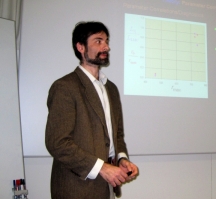

Professor of Astrophysical, Planetary, and Space Sciences
School of Physics, Astronomy, and Computational Sciences
College of Science, George Mason University
pbecker@gmu.edu, 703-993-3619 (voice), 703-993-1993 (fax)

Dr. Becker received the PhD degree in Astrophysics from the University of Colorado at Boulder in 1987, working under the supervision of Dr. Mitchell C. Begelman at the Department of Astrophysical and Planetary Sciences.
From 1987 to 1989, Dr. Becker held a postdoctoral fellowship at the Department of Astronomy at the University of Virginia, and during 1989-1992, he was an NRC/NAS Cooperative Research Associate at the Space Science Division of the Naval Research Laboratory in Washington, D.C. Since 1992, Dr. Becker has been a faculty member at George Mason University. He is affiliated with the Department of Physics and Astronomy in the College of Science.
Dr. Becker's research focuses on a variety of topics in high-energy astrophysical theory, including theoretical modeling of accretion flows onto rotating neutron stars (X-ray pulsars) located in binary systems. The gas falling onto the surfaces of X-ray pulsars experiences the most extreme conditions in the known universe, including super-strong magnetic and radiation fields, and extreme gravity and density. The model he has developed for these sources has become the standard model used by researchers all over the world studying these extreme and highly energetic objects. Dr. Becker is also actively involved in the theoretical modeling of time-dependent transients (“flickers”) observed in the X-ray spectra emitted by black holes located in the centers of active galaxies. The goal of this work is to decode the information contained in the rapidly varying X-ray signals from these sources, in order to learn more about the properties of the gas creating the observed radiation. Additional areas of research include fundamental studies of the acceleration of charged particles in shock waves. This process is of widespread importance in astrophysics and solar physics, and is the underlying mechanism driving the propagation and evolution of coronal mass ejections from the solar atmosphere, which can propagate through interplanetary space to adversely affect conditions in the Earth’s magnetosphere. He has authored or co-authored more than 70 refereed journal articles.
